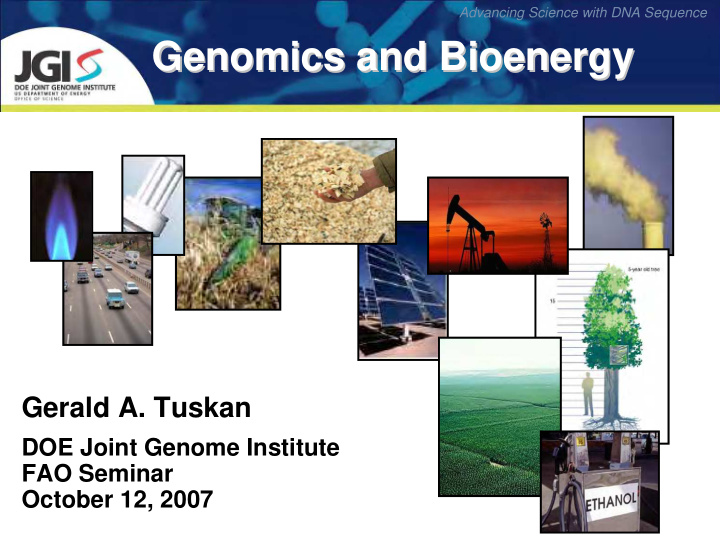



Advancing Science with DNA Sequence Genomics and Bioenergy Genomics and Bioenergy Gerald A. Tuskan DOE Joint Genome Institute FAO Seminar October 12, 2007
Advancing Science with DNA Sequence U.S. Energy Consumption U.S. Energy Consumption and the Economy and the Economy ● The U.S. consumes roughly 26% of the world’s energy; yet represents about 6% of the world’s population ● There is a linear relationship between energy consumption and gross domestic product ● Many developing countries are adopting the U.S. social, economic and energy-use model
Advancing Science with DNA Sequence U.S. Energy Production & U.S. Energy Production & Consumption Consumption Energy Flow 2005 Source: http://www.eia.doe.gov/ (105 Quadrillion Btu)
Advancing Science with DNA Sequence U.S. Energy Consumption by U.S. Energy Consumption by Source and Sector Source and Sector Source: http://www.eia.doe.gov/
Advancing Science with DNA Sequence U.S. Crude Oil Production U.S. Crude Oil Production ● Domestic production has declined over the past 20 years and is expected to continue to decline ● Consumption is growing and imported oil is meeting this demand ● Continuing with business as usual has economic, environmental and national security consequences Source: http://www.eia.doe.gov/
Advancing Science with DNA Sequence Increases in Atmospheric CO 2 Increases in Atmospheric CO 2 Source: http://cdiac.ornl.gov/ftp/trends/co2/maunaloa.co2
Advancing Science with DNA Sequence World CO 2 Emissions World CO 2 Emissions Source: http://www.eia.doe.gov/
Advancing Science with DNA Sequence Renewable Energy in the U.S. Renewable Energy in the U.S. Source: http://www.eia.doe.gov/
Advancing Science with DNA Sequence Long- -term Supply Options term Supply Options Long Source: Steven Koonin, 2006, BP
Advancing Science with DNA Sequence How do we . . . How do we . . . ● Reduce our need for imported sources create create of energy? ● Maintain our standard of living? Closed– –loop domestic loop domestic Closed ● production of lignocellulosic production of lignocellulosic Reduce our carbon emissions? biofuels biofuels ? ? ● Preserve our energy security? ● Maintain our reliance on affordable transportation fuels?
Advancing Science with DNA Sequence Role of Biology Role of Biology Sun Cellulose Sugar Alcohol Biomass converting Fermenters Feedstocks organisms Poplar Termite Pichia stipitis Soybean, Maize, • White Rot Fungus • Tamar wallaby forestomach • Thermoanaerobacter Switchgrass, • Clostridium thermocellum • Poplar biomass degraders ethanolicus Miscanthus, Sorghum, • Saccharophagus degradans • Asian Longhorned Beetle gut • Pichia stipitis Cotton, Brachypodium • Acidothermus cellulolyticus • Elephant Grass decomposers
Advancing Science with DNA Sequence Dedicated Energy Crops – – Dedicated Energy Crops The Monocots The Monocots Potential Energy Crop Model Genome Switchgrass Miscanthus Foxtail Millet Informative Genome Oryza Monocots Maize Potential Energy Crop Model Genome Switchgrass Miscanthus Sorghum Informative Genome Model Genome Monocots Wheat Musa Informative Genome Brachypodium Monocots
Advancing Science with DNA Sequence Dedicated Energy Crops – – Dedicated Energy Crops The Dicots The Dicots Potential Energy Crop Glycine Model Genome Oil production Glycine Populus Informative Genome Arabidopsis Legumes Prunus Eucalyptus Populus Prunus Potential Energy Crop Model Genome Model Genome Eurosid II Woody Perennial Eucalyptus Informative Genome Informative Genome Populus Eurosid I
Advancing Science with DNA Sequence Accelerated Domestication Accelerated Domestication Apply advanced, modern genetic and genomics techniques to accelerate the domestication rate in fast growing short-rotation tree species.
Advancing Science with DNA Sequence Corn Domestication Corn Domestication • Modern Hybrids • Corn Landraces • Teosinte Timeline: 5000 ybp 2000 ybp Today
Advancing Science with DNA Sequence Populus Domestication Populus Domestication Domesticated Trees Improved Hybrids Clonal Selection Wild Stands Timeline: 30 M - 200 ybp 120 ybp Today The Future?
Advancing Science with DNA Sequence Fully Domesticated Poplar Fully Domesticated Poplar • Reduced recalcitrance of cellulose degradation • Reduced height growth • Compact crown • Higher productivity per unit area • Greater number of stems per unit area • Compact root system • Drought/Stress tolerance • Enhanced radial growth • Nutrient use efficiency • Greater product yield • Reduced flowering
Advancing Science with DNA Sequence Functional Relationship Between Functional Relationship Between Yield & Cost of Energy Crops Yield & Cost of Energy Crops Accelerated domestication approach Current conventional approach Cost ($/ton) 1st 10 Generations 2nd 10 Generations Yield (ton/ac/yr)
Advancing Science with DNA Sequence Novel Gene Function: Novel Gene Function: The Aux/IAA16 subgroup The Aux/IAA16 subgroup RNAi-mediated down- AtIAA16 loss-of- regulation of PoptrIAA16.31 function mutants results in radial growth in expressed no Populus. visible phenotype. IAA16.3 IAA16.3 transgenic control 7.1 4.4 stem cross sectional area (cm 2 ) Control Control 90-day-old Populus cuttings
Advancing Science with DNA Sequence Summary & Conclusions Summary & Conclusions ● The U.S. consumes approximately 25% of the world’s energy. ● 85% of the U.S. total is from fossil fuels. ● Short-rotation Populus systems offer a plausible means of supplying biomass for conversion to liquid transportation fuels. ● Increases in average productivity will require accelerated domestication approaches. ● Access to the complete catalog of Populus genes will facilitate the development of domesticated tree systems through functional genomics approaches.
Advancing Science with DNA Sequence
Recommend
More recommend